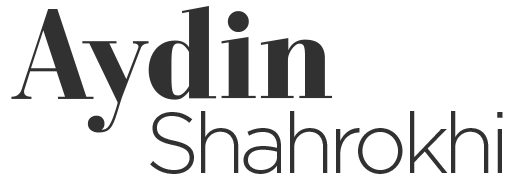CASE STUDY
BROAD RIVER RETAIL WEBSITE REDESIGN
Project Overview
Project Title: Broad River Retail Corporate Website Redesign
Role: Project Lead (UX/UI Design, Information Architecture, Content Strategy, Project Management)
Timeline: Mid-August 2021 – Mid-December 2021 (approx. 4 months)
Platform: WordPress
Problem Statement: Broad River Retail’s existing corporate website suffered from an outdated design, broken functionalities, a lack of clear information hierarchy, and a fragmented user experience, hindering brand awareness and talent acquisition efforts.
Key Goals:
Transform the website into a modern, clean, and easily navigable digital platform.
Significantly enhance brand awareness and professional image.
Create a compelling resource to attract and inform job seekers about company culture and opportunities.
Establish a consistent design system and improve overall user experience.
The Challenge: A Disjointed Digital Presence
Before the redesign, Broad River Retail’s website presented several critical issues:
Outdated Aesthetics & Brand Misalignment: The previous design featured an “industrial look and feel” that was no longer representative of the company’s modern brand identity. It lacked visual appeal and failed to maximize screen real estate, leading to a cluttered appearance.
Poor Information Architecture & Usability: Content was disorganized, with “collect-all” pages that made it difficult for users to find specific information. The absence of clear hierarchies and a consistent design system resulted in a frustrating and inefficient user journey.
Ineffective Talent Attraction: A primary business objective was to attract top talent. However, the existing “Careers” section was rudimentary, offering little insight into the company’s culture, values, or employee experience, thus failing to “sell” Broad River Retail to potential candidates.
Technical Instability: The website was frequently “broken” or buggy, leading to a poor impression and potential loss of user trust.
These challenges collectively undermined Broad River Retail’s online presence, impacting its ability to communicate its value proposition effectively to both customers and prospective employees.
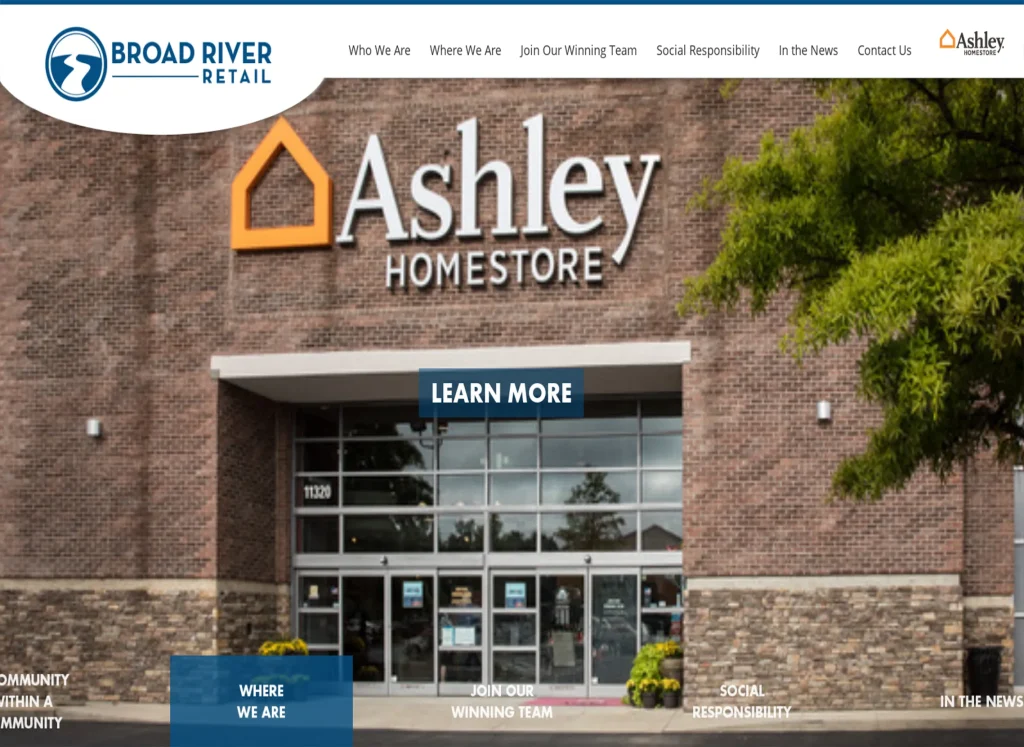
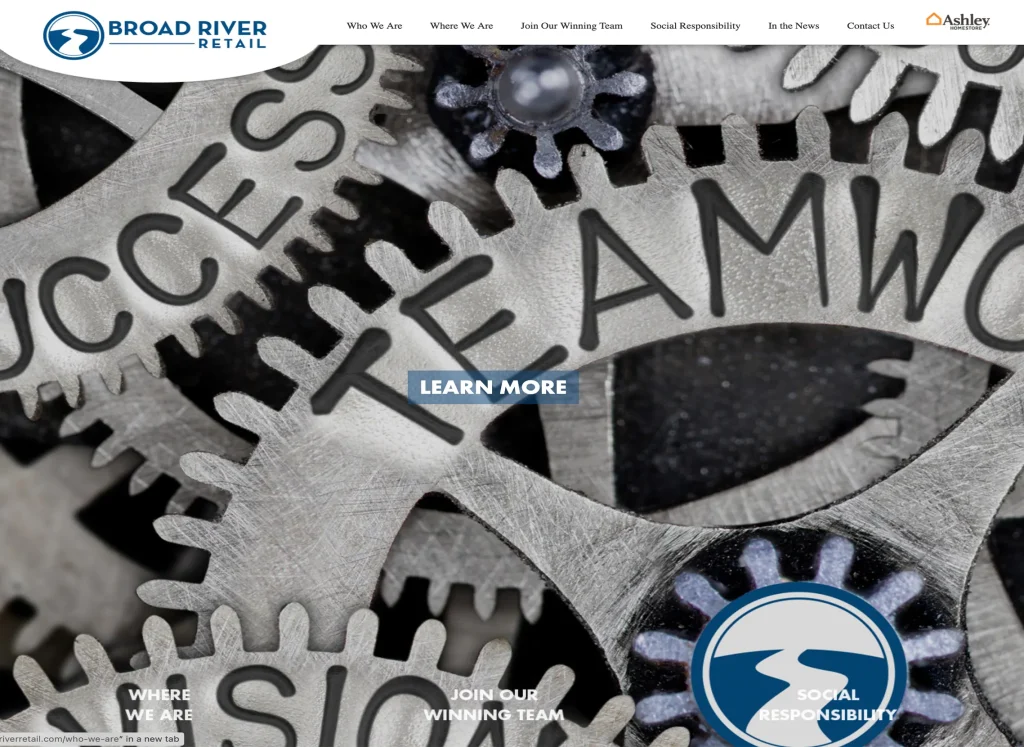
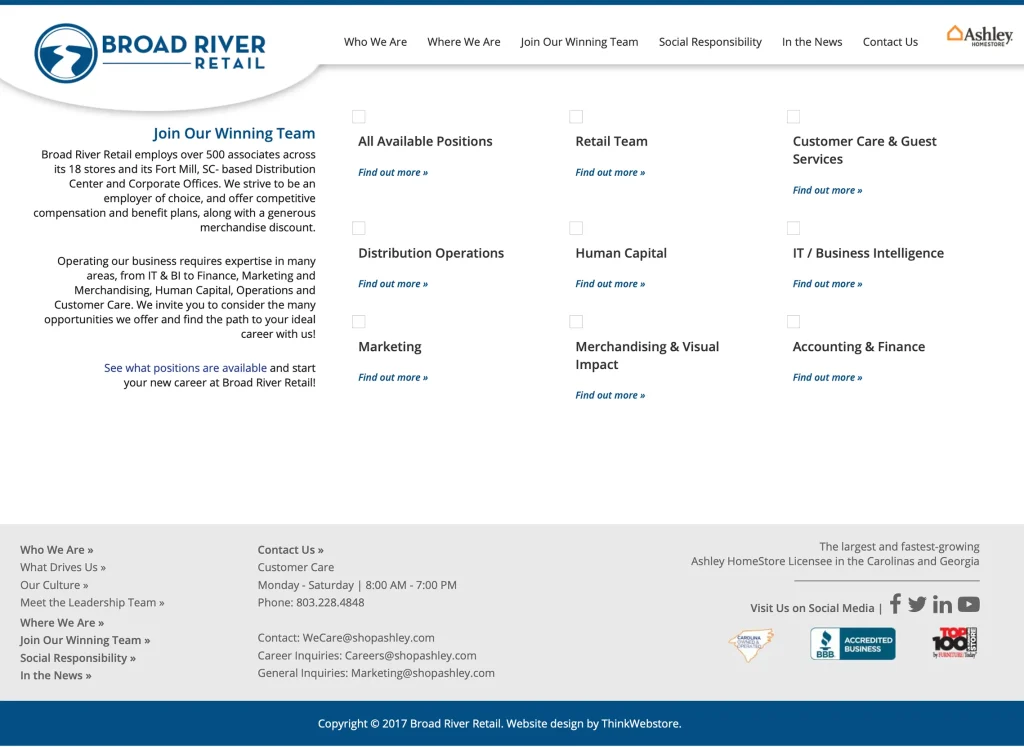
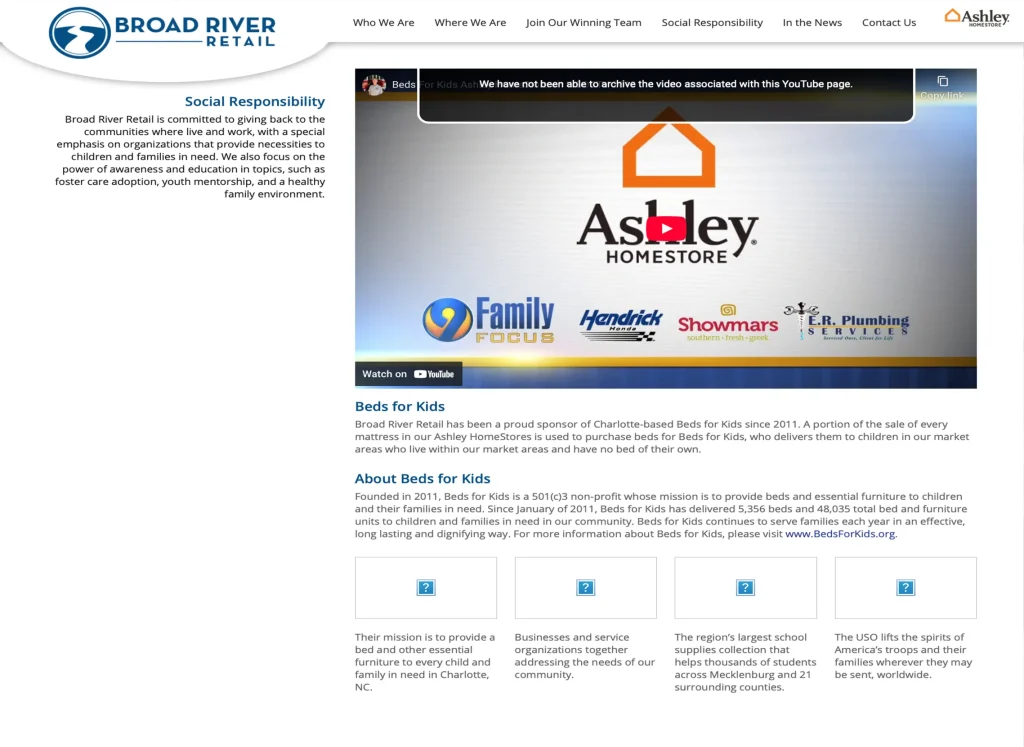
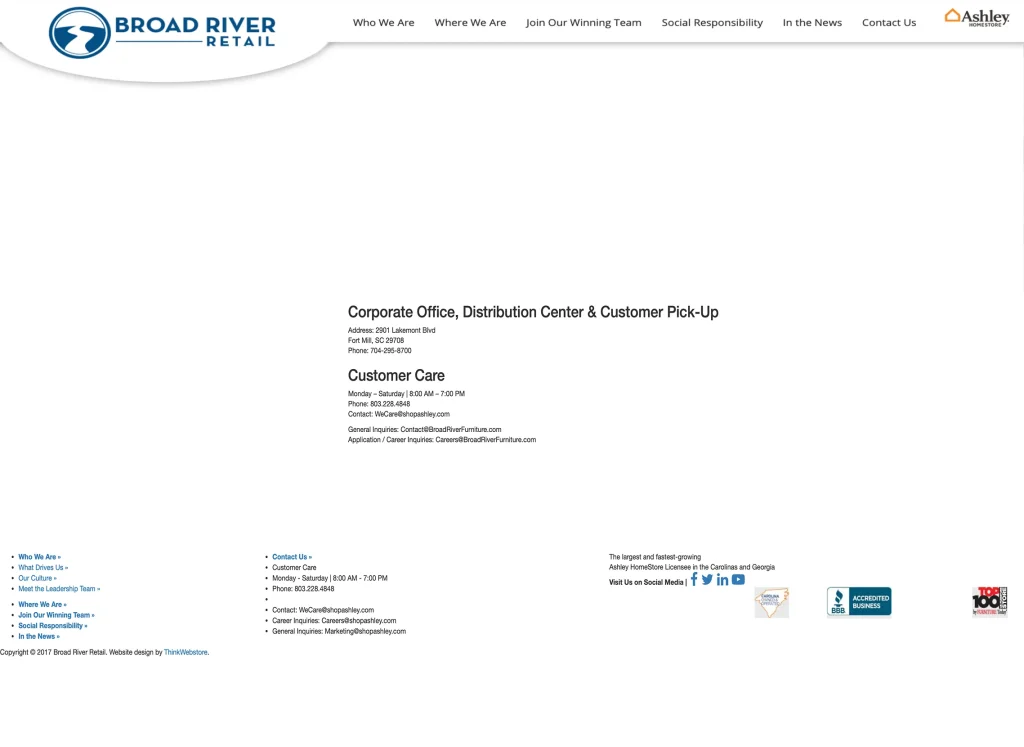
My Role & Approach: Leading a Collaborative Transformation
As the sole project lead, working under the direction of the Creative Manager and Marketing and Communication Director, I managed the entire redesign process from conception to launch. My responsibilities encompassed:
Strategic Planning: Defining project scope, objectives, and key deliverables in alignment with leadership’s vision.
User Experience (UX) Design: Conducting informal research, developing information architecture, and mapping user flows and journeys.
User Interface (UI) Design: Crafting the visual design, ensuring brand consistency, and creating a modern aesthetic.
Content Strategy: Collaborating with internal teams (including the CEO and COO) to gather, organize, and optimize content for the new site.
Project Management: Overseeing the development process, ensuring adherence to the aggressive timeline, and managing all technical aspects on WordPress.
My approach was highly collaborative on the content front, leveraging informal conversations and structured discussions with leadership to gain critical insights into business needs and desired messaging. This allowed for a lean, agile process, adapting quickly to feedback while maintaining focus on the core objectives.
Research & Discovery: Understanding Needs and Pain Points
While formal, extensive user interviews were not conducted due to project constraints, my research phase involved crucial stakeholder engagement and analysis:
Stakeholder Interviews (Informal): I conducted focused conversations with key leadership members, including the CEO and COO. These discussions served as informal stakeholder interviews, providing invaluable insights into:
Business Objectives: Understanding the overarching goals for the website, particularly the emphasis on brand awareness and talent acquisition.
Target Audience Needs: Gaining clarity on what information job seekers and other visitors needed and expected from the site.
Brand Vision: Capturing the desired modern aesthetic and tone for the Broad River Retail brand online.
Content Priorities: Identifying critical content areas and messaging that needed to be highlighted. These conversations were instrumental in shaping the project’s direction and ensuring alignment with strategic business goals.
Existing Website Audit: A thorough review of the old website identified key pain points: broken links, outdated content, poor navigation, and visual inconsistencies. This audit directly informed the “before” picture and highlighted areas for immediate improvement.
Competitive Analysis (Informal): Reviewing industry best practices and competitor websites to identify modern web design trends and effective ways to present corporate information and career opportunities. The old deck provided examples of desired card and tile slideshow functionalities, which served as inspiration.
Design Process & Solutions: Crafting a Modern, User-Centric Experience
Based on the research and defined goals, I implemented a comprehensive redesign strategy:
1. Information Architecture (IA) & Navigation Overhaul
Simplified Navigation: Replaced the cluttered top navigation with clear, concise categories: “WHO WE ARE,” “WHERE WE ARE,” “JOIN A WINNING TEAM,” “SOCIAL RESPONSIBILITY,” and “HEADLINES.” This streamlined the user journey and improved discoverability.
Content Restructuring: Transformed “collect-all” pages into focused, digestible sections. For example, the “About” page was redesigned into “WHO WE ARE” with dedicated sub-sections like “What Drives Us,” “Our Culture,” and “Meet the Leadership Team.”
2. User Flow & Journey Mapping (Conceptual)
While not formally documented with visual diagrams, the insights from stakeholder conversations and the existing site audit implicitly informed the conceptual development of user flows and a high-level journey map. This mental modeling helped in:
Defining Key User Paths: Identifying the primary routes users would take, such as a job seeker landing on the homepage and navigating to “Join a Winning Team” to learn about company culture and view openings.
Optimizing Conversion Points: Ensuring that critical calls to action (e.g., applying for a job, contacting the company) were easily accessible and intuitive within the user’s journey.
Anticipating User Needs: Considering the information users would seek at each stage of their journey and ensuring that content was presented logically and concisely. This conceptual mapping was crucial for designing an intuitive and efficient user experience.
3. Visual Design & Brand Modernization
Lighter & Modern Aesthetic: Shifted from the previous industrial look to a clean, light, and contemporary design. This involved a refreshed color palette, modern typography, and ample white space to enhance readability and visual appeal.
Maximized Real Estate: Implemented responsive layouts that efficiently utilized screen space, eliminating clutter and ensuring optimal viewing across all devices (desktop, tablet, mobile).
Updated Branding Elements: Integrated the new company logo, updated social media icons, and ensured consistent placement of key brand elements (Ashley logo, BBB, Top 100, Carolina Owned & Operated) in the footer.
4. User Experience (UX) Enhancements & Feature Implementation
Enhanced “Join a Winning Team” Section: This was a critical focus. The new section goes beyond simple job listings, offering rich content on “life at Broad River Retail,” including company events, training, volunteering, and work-life balance photos. This directly addressed the goal of “selling” the company culture to job seekers.
Interactive Leadership Profiles: For the “Meet the Leadership Team” page, implemented interactive profiles where clicking a team member’s picture reveals their bio in a pop-up, providing detailed information without cluttering the main page.
Dynamic “Headlines” (News) Section: Redesigned the news page to display the most current stories with thumbnails and headlines, offering a more engaging format. An “archive” icon was added to provide access to older articles and press releases on a separate page.
Improved Contact & Location Pages: Redesigned the “Contact” page to be more visually appealing and aligned with the new site’s aesthetic, moving it to the footer as a direct link. The “Where We Are” page was cleaned up to provide a better user experience for finding store locations.
WordPress Implementation: Leveraged WordPress’s flexibility for content management, ensuring easy updates and scalability for future growth.
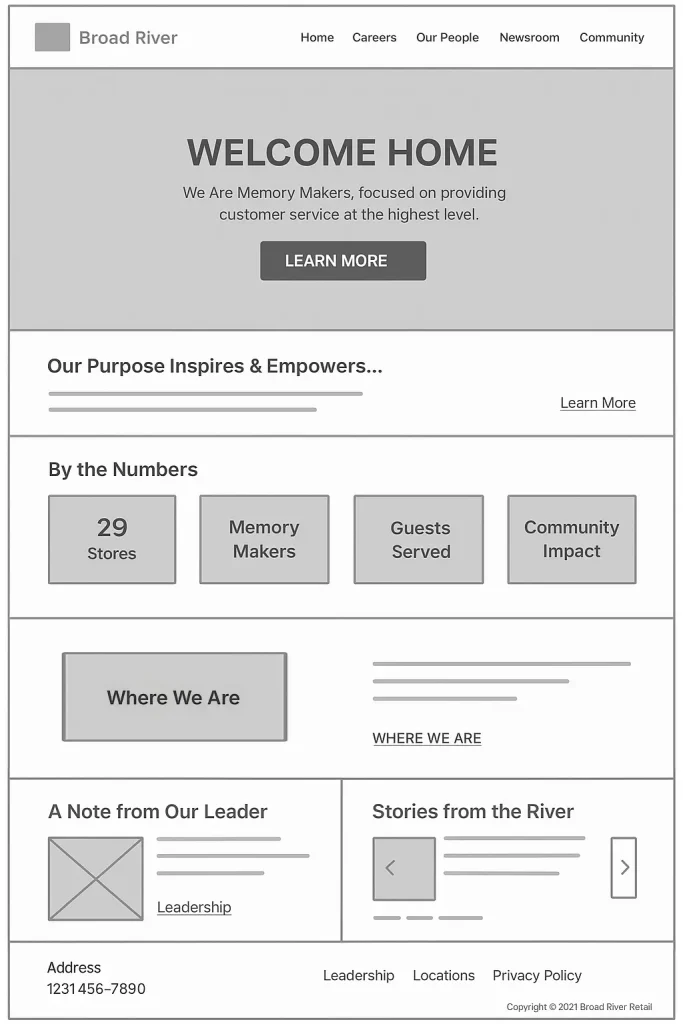
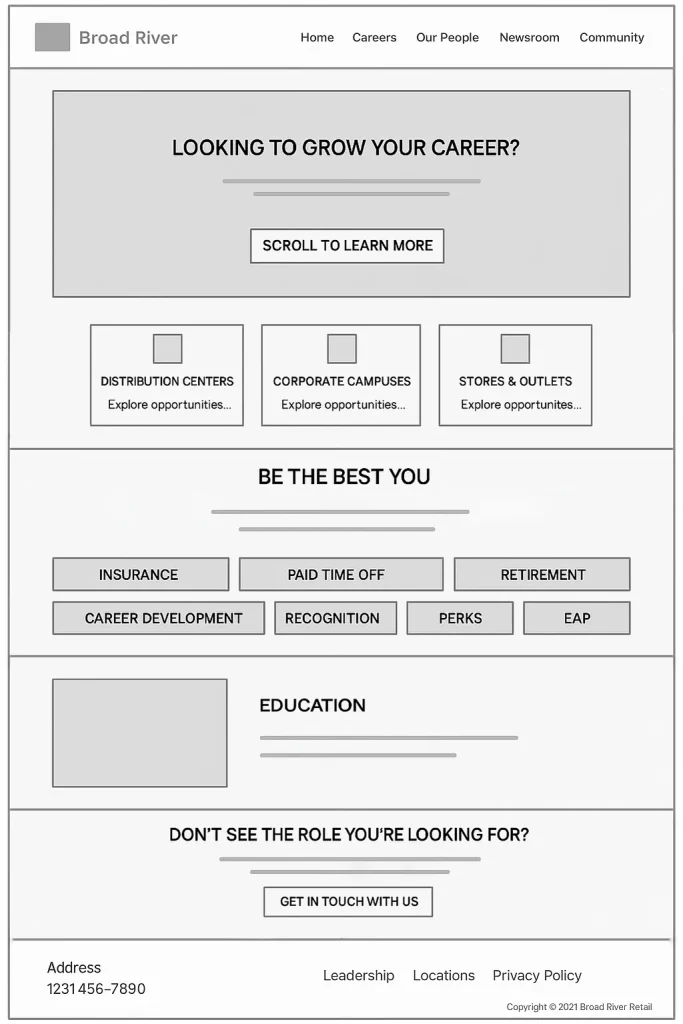
Results & Impact: A Transformed Digital Identity
The Broad River Retail website redesign was successfully launched within the aggressive timeline, delivering a significant transformation of the company’s digital presence:
Elevated Brand Image: The new website presents a highly professional, modern, and inviting image, effectively enhancing Broad River Retail’s brand awareness and credibility in the market.
Improved Talent Acquisition: By providing comprehensive and engaging content about company culture, values, and career opportunities, the website became a powerful tool for attracting and informing prospective employees, directly supporting a key business objective.
Employee Excitement & Approval: A post-launch survey distributed to over 1,000 employee members garnered a remarkable 98% positive response, indicating widespread excitement and approval for the new website. This feedback underscored the successful communication of company culture and values.
Enhanced User Experience: The intuitive navigation, clean design, and responsive layout dramatically improved usability, making it easier for all visitors to find information and engage with the brand.
Leadership Endorsement: A comprehensive meeting with company leadership to showcase the redesigned website received overwhelmingly positive and enthusiastic feedback, validating the project’s success in meeting strategic objectives and enhancing the company’s digital presence.
Operational Efficiency: The move to WordPress and a structured content approach streamlined content updates and maintenance, reducing the likelihood of “broken” pages.
This project demonstrated my ability to lead a complex digital transformation end-to-end, from strategic planning and UX/UI design to content integration and project execution, all while working within a lean team structure and under the guidance of key stakeholders. The redesigned Broad River Retail website stands as a testament to the power of user-centered design in achieving critical business objectives.
